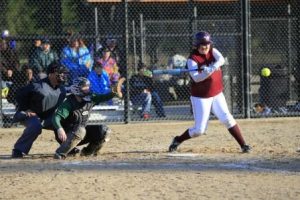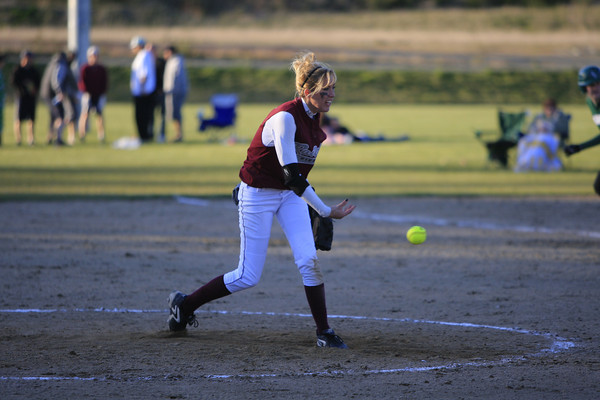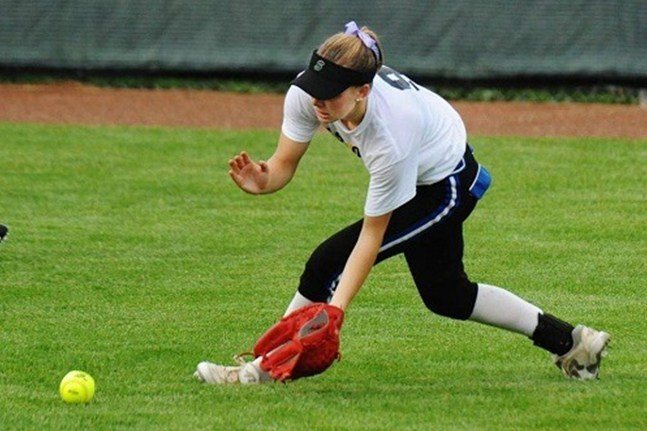The basic softball rules are where the education should begin with every beginner softball player. This page will focus on the terminology of softball.
Batter: Person in the batters box attempting to hit the ball from the pitcher. Pitcher: Person in the pitching circle who throws the ball in an attempt to get the batter out.

Steinwender Batters Box: The area surrounding home plate where the batter must stand while trying to hit the ball.
Pitching Circle: Area on the field where pitcher must throw the ball from to the batter. The pitching circle contains the pitching rubber.
Pitching Rubber: The rectangular piece of rubber in the middle of the pitching circle from which the pitcher must throw the ball. The pitcher is required to maintain contact with the pitching rubber until the release of the ball.
Strike zone: The area over home plate that is lower than the chest of the hitter, generally from the “letters” of the name of the team, to just above the hitters knees. If a ball is thrown through this area, it is a called strike.
Strike: A pitch thrown through the strike zone that the hitter does not hit, either by swinging or not. A strike is also any pitch that a batter swings at but misses. A foul ball hit with less than two strikes is considers a strike, unless it is caught. If it is caught, the batter is out. Three strikes is an out if three strikes are thrown before four balls. It can be any combination of called strikes, swinging strikes or foul balls. However, the final strike must be either a called strike or swing and miss strike. A third strike can also be recorded if a batter swings and fouls the ball directly into the catcher’s glove and the catcher catches it.
Ball: A ball is any pitch that is not swung at and is not in the strike zone. If four “balls” are thrown before three strikes are recorded, then the batter has earned a walk, and gets to go to first base. If there is a runner on first base, they get to move to the next base without a play. All runners on consecutive bases can safely move to the next base (i.e. runners on first and second base or runners on first, second and third base). If runners are not on consecutive bases (runner on second, but no one on first) the runner on nonconsecutive bases does not advance. Base runner: A batter who has legally reached base either via walk or hit. A team can have no more than three base runners at a time (one on each base; first, second and third).
Out: An out occurs when either a hitter or base runner is legally removed from play by the opposing team. A hitter can make an out either by striking out, hitting a ground out or hitting a pop or fly out. A base runner can make an out either by being tagged with the ball when not on the safety of one of the bases or by being “forced” out. A force out is where a runner must advance to the next base on a grounder that was hit, and the previous base is occupied or hitter is now running to first. A force out means the fielder has to touch that base versus tag the runner coming to that base.

Fly ball : A ball that is hit in the air. It can also be called a pop up or line drive. A line drive is a ball hit in the air that is hit at a fairly consistent height from the ground. A pop up is one that is hit in an arc.
Fly out: A ball that is hit in the air and caught by the opposing team before it hits the ground. A pop out (a pop up caught in the air) and line out (a line drive caught in the air) are variations of the fly out.
Inning: During an inning, each team gets to bat until they make three outs. Once one team makes three outs, then the other team gets a turn to bat until it makes three outs. In some of the younger age groups, an inning can also end by various other means, like each team permitting everyone to bat once or three outs whichever comes first, or each team is permitted to score up to a certain number of runs or three outs are recorded, whichever comes first. Error: Where a fielding player mishandles or mis-throws a hit ball (grounder or fly ball) and the batter safely advances to a base on what, if the fielder had handles or throws the ball correctly, would have resulted in an out.
Single: A hit ball where the batter advances to first base safely without an error committed by a fielder.
Studio Double: A hit ball where the batter advances to second base safely without an error committed by a fielder.
Triple: A hit ball where the batter advances to third base safely without an error committed by a fielder.
Homerun: A hit ball where the batter advances to all three bases and returns to home plate safely without an error committed by a fielder. A homerun can either be “out of the park” meaning a ball hit over the outfield fence in fair territory or “in the park” meaning the batter advanced around all of the bases and returned to home plate before the fielding team could tag the batter out.
Grand Slam: A homerun hit with the bases loaded, or runners on first second and third. So this is a start for the basic softball rules lexicon. There are many more terms not included here, so why not add them in below.
